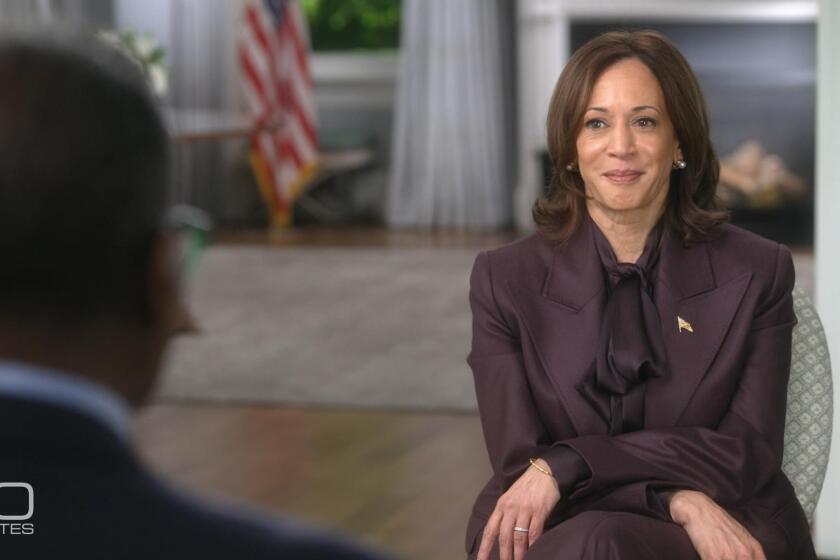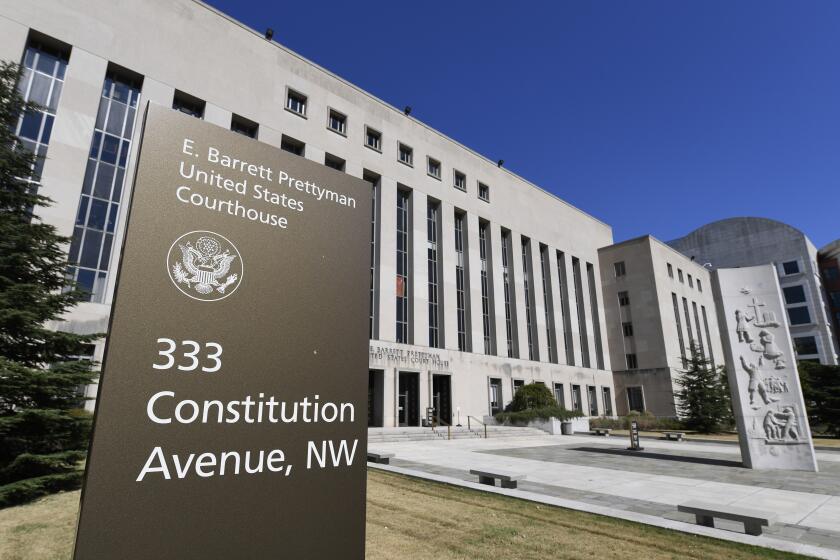Column: Bread & Roses: Elizabeth Warren’s presidential announcement honors a great event in labor history
- Share via
The Democratic Party lately has been striving to portray itself as a bulwark for the American worker, but it hasn’t done as much to place organized labor at the forefront of its platform.
That may be about to change. Sen. Elizabeth Warren (D-Mass.) has scheduled the formal announcement of her presidential candidacy Saturday in the old mill town of Lawrence, Mass. The symbolism is unmistakable. Lawrence was the site of one of the most important — and successful — strikes in U.S. labor history, the 1912 “Bread and Roses Strike” of textile workers.
Warren has made sure the connection isn’t overlooked. “Lawrence has a history of working people coming together to make change, where the fight was hard, the battle was uphill, and where a group of women led the charge for all of us,” she says in a video posted on her campaign website.
The woman worker needs bread, but she needs roses too.
— Labor activist Rose Schneiderman, 1911
The location also allows her to make deeper points about the plight of American workers in the U.S. and global economies.
“Lawrence is very representative of where the nation has gone,” says Erik Loomis, an expert in labor history at the University of Rhode Island whose 2018 book, “A History of America in Ten Strikes,” aims to restore to American consciousness a labor movement that has been written out of the standard history textbooks. “You have the story of this amazing labor victory, but then for a very long time Lawrence has been depressed, it’s a symbol of industrialization, it’s a symbol of an America left behind in the new economy, it’s a symbol of the immigrant past and also the immigrant present.”
Loomis places the Bread and Roses Strike at the dead center of his chronicle of American history. His book starts with the Mill Girls Strike of 1834 in Lowell, Mass. — only 10 miles from Lawrence (mill owners in both cities exploited power from the Merrimack River to run their machines) — and carries the story through to the Justice for Janitors campaign of the 1980s and ’90s, stopping along the way at the eight-hour-day strikes of the Gilded Age, the Flint, Mich., sit-down strike of autoworkers in the mid-1930s, and the disastrous air-traffic controllers’ strike of 1981, among other way stations.
Among the threads running throughout the book is the tradition of government hostility to organized labor, expressed through often violent suppression of strikes by police or soldiers. That point tends to be overlooked even in labor histories, Loomis told me. “Labor historians place an enormous emphasis on ideas of solidarity and radical actions, but not enough on the basic issue that there is almost no strike in American history that succeeded when the government was actively opposed to that strike.”
The Bread and Roses Strike might be an exception. (The name generally is thought to have come from labor activist Rose Schneiderman, who declared in a 1911 speech, “The woman worker needs bread, but she needs roses too” — the bread signifying better pay, the roses the schools, training and amenities that brought dignity to the working woman’s life.)
The strike began on Jan. 12, 1912, the day a new Massachusetts law limited working women’s hours to 54 a week, a reduction of two hours. Mill owners in Lawrence cut the workers’ pay to match the new hours. Workers walked off the job in protest, and as Loomis reports, within a day the entire city was shut down.
Lawrence was the quintessential New England mill town, employing a quintessentially mill-town workforce of 40,000, mostly immigrants from Ireland and southern and eastern Europe, Loomis relates. Half the workers at the city’s biggest mill, the American Woolen Co., were women younger than 18, “toiling for little pay and breathing cotton dust.” The average weekly wage was $9; the average weekly tenement rent, $6. The average life expectancy was less than 40.
The mill workers’ strike promptly attracted organizers from the Industrial Workers of the World, or “Wobblies,” who helped solidify the movement and hoped it could be expanded into a mass strike. Among the Wobbly luminaries who made appearances on the scene were key organizer Elizabeth Gurley Flynn and I.W.W. co-founder “Big Bill” Haywood himself.
The government played its customary role of violence and suppression. Police deluged striker rallies with water from fire hoses in subfreezing temperatures. A militia member bayoneted one marcher to death. The police murder of another was pinned on strike leaders. Harvard students mobilized as a strikebreaking force — a tradition, Loomis writes, in an era when university education was exclusively an option for the wealthy elite. Harvard allowed the students to make up their final exams later.
The Wobblies managed to turn the strike into a popular cause. The strike attracted sympathetic writers and donations from nationwide. When the Wobblies arranged railroad evacuation of strikers’ children to communities of sympathizers willing to keep them clothed and fed for the duration, the rail boardings were covered by the press, as were the children’s arrivals in New York.
When one evacuation was blocked by Lawrence police, who fomented a melee, the attack gained the attention of President William Howard Taft, who ordered an investigation. A congressional committee took testimony from workers, who described suffering horrific injuries on the factory floor and being charged even for clean drinking water.
Under the onslaught of negative publicity, the mill owners relented, awarding the workers a wage increase of up to 20% and overtime pay, Loomis writes. The strike leaders framed for murder were acquitted.
But the solidarity so painstakingly promoted by the I.W.W. did not last. Wobbly membership in Lawrence collapsed within two years, in part because the economy had turned down and because the Wobblies had little grasp of long-term organizing.
“The strike had won the workers some material gains,” Loomis writes, “but it left them no union to keep up the fight.”
That could serve as the moral of the story of American organized labor more generally. Union membership in the private sector has declined sharply since its heyday in the 1940s and 1950s, coinciding almost exactly with the growth in the share of national income going to the top 10%.
Democratic Party support for organized labor has been strong, if not always as overt as Warren seems intent on making it. The Obama-era National Labor Relations Board took significant steps to address workplace abuses such as the improper designation of employees as contract workers or the use of labor contractors to obscure the employment relationship between companies such as fast food chains and the workers on their front lines. Obama took aim in executive orders against such abuses as forced arbitration of workplace claims. (Many of those initiatives have been rolled back by the Trump White House.)
It’s also true that unions have made recent gains in some white-collar sectors such as journalism, where relentless layoffs and the threat of more cost-cutting have prompted editorial staff to organize at newspapers and magazines such as the Los Angeles Times and the New Yorker and digital news sites including Huffpost, the Intercept, Vox and Salon.
Warren’s initiative signals that the political establishment may be regaining a sense of the value of collective bargaining that hasn’t been seen in Washington in such strength since the New Deal and the enactment of the National Labor Relations Act in 1935. That’s important because workers’ organizing rights have come under the most concerted attack by federal courts, including the Supreme Court, in decades.
Loomis also points to the success of teachers’ strikes in Chicago, West Virginia and, most recently, Los Angeles, which retained popular support in part because their organizers linked the gains sought for teachers with the prospect of improved schoolroom conditions for pupils. The specter of unionized action by aviation workers — FAA inspectors, air traffic controllers, and flight attendants — also seems to have played a role in forcing President Trump to reopen the government after the recent 35-day partial shutdown.
“Strikes are a mixed bag,” Loomis told me. “Sometimes they’re a brilliant strategy, sometimes a terrible one. Sometimes they’re done for the right reason and sometimes not.” But the Bread and Roses Strike in Lawrence shows how much they can accomplish at the right moment and the right place. “If they’re used properly, they can be the most effective tactic labor has.”
By making her presidential announcement from the steps of a Lawrence mill building, Elizabeth Warren seems to be linking her campaign to the idea that the key to restoring economic stability to the average workers’ lives is to restore their ability to stand together.
Keep up to date with Michael Hiltzik. Follow @hiltzikm on Twitter, see his Facebook page, or email michael.hiltzik@latimes.com.
Return to Michael Hiltzik’s blog.
More to Read
Get the L.A. Times Politics newsletter
Deeply reported insights into legislation, politics and policy from Sacramento, Washington and beyond. In your inbox twice per week.
You may occasionally receive promotional content from the Los Angeles Times.











